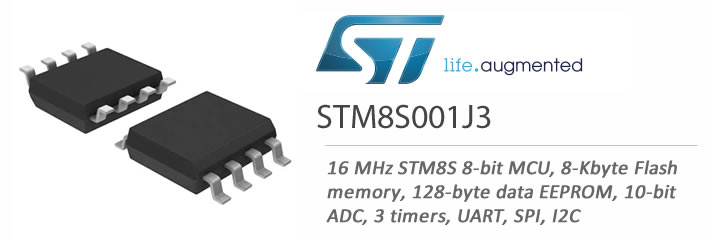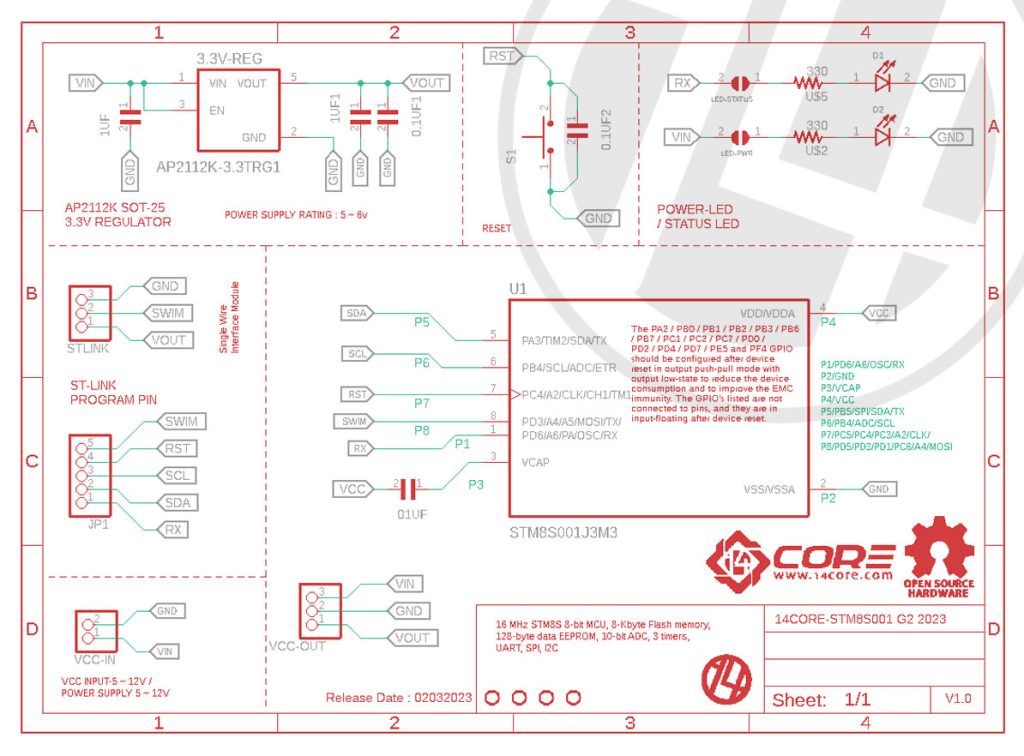STM8S001 is a microcontroller from STMicroelectronics, which is a member of the STM8S family of 8-bit microcontrollers. This microcontroller is based on a high-performance 8-bit STM8 core with Harvard architecture, which enables it to deliver efficient performance and high code density.
STM8S001J3 microcontroller has a wide range of features, including:

- 8 MHz internal oscillator
- 8 KB Flash memory
- 1 KB RAM memory
- 128 bytes EEPROM memory
- 5-channel 10-bit ADC
- 1-channel 16-bit timer
- 1-channel basic timer
- 1-channel SPI
- 1-channel I2C
- 2-channel UART
- Up to 20 GPIOs
STM8S001 is ideal for a wide range of applications, including industrial control systems, consumer electronics, home appliances, and automotive systems. Its small size, low power consumption, and rich feature set make it a popular choice among developers looking for an affordable yet capable microcontroller solution.
STM8S001 & STM8 Family microcontroller can be used in a wide range of applications that require low power consumption and high performance. Some of the typical use cases for this microcontroller include:
- Industrial control systems: The STM8S001 can be used to control industrial processes and machinery, such as manufacturing equipment, robotics, and motor control systems.
- Consumer electronics: The microcontroller can be used in a wide range of consumer electronics applications, such as smart home devices, wearable technology, and handheld devices.
- Home appliances: The STM8S001J3 can be used in home appliances such as washing machines, refrigerators, and air conditioning systems to control their operation and functionality.
- Automotive systems: The microcontroller can be used in automotive systems such as engine control modules, body control modules, and infotainment systems.
- LED lighting control: The STM8S001 has multiple I/O pins that can be used to control LEDs, making it a good choice for simple lighting control applications.
- Sensor monitoring: The STM8S001 has an ADC that can be used to measure analog sensor inputs, making it suitable for applications such as temperature, humidity, or light level monitoring.
- Motor control: The STM8S001J3 has multiple timer channels and PWM outputs, which can be used for controlling motors or other devices that require precise timing.
- Home automation: The STM8S001J3 can be used in home automation applications, such as controlling lights, temperature, or security systems.
- IoT devices: The STM8S001J3 is a low-power microcontroller, making it suitable for battery-powered IoT devices such as smart sensors or wireless nodes.
- Audio applications: The STM8S001J3 has a built-in DAC that can be used for generating audio signals, making it suitable for simple sound generation or music playback.
- Gaming console: The STM8S001J3 can be used to build a simple gaming console, with buttons, LEDs, and sound effects. The microcontroller can be used to read inputs from the buttons, generate sound effects using the built-in DAC, and control the LEDs.
- Temperature controller: The STM8S001J3 can be used to build a simple temperature controller, with a thermistor or other temperature sensor and a relay. The microcontroller can read the temperature sensor and turn on or off the relay to control a heater or cooler.
- RFID reader: The STM8S001 can be used to build an RFID reader, with an RFID module and an LCD display. The microcontroller can read the RFID tags and display the data on the LCD screen.
- Smart agriculture: The STM8S001J3 can be used to build a simple smart agriculture system, with soil moisture sensors and irrigation valves. The microcontroller can read the moisture sensors and control the valves to water the plants when necessary.
- Traffic light controller: The STM8S001J3 can be used to build a simple traffic light controller, with LEDs and a timer. The microcontroller can control the LEDs to simulate a traffic light sequence, using the built-in timers to time the different phases.
- Data logger: The STM8S001J3 can be used to build a simple data logger, with sensors and an SD card. The microcontroller can read the sensors and write the data to an SD card for later analysis.
- Audio spectrum analyzer: The STM8S001 can be used to build a simple audio spectrum analyzer, with an audio input and an LCD display. The microcontroller can sample the audio input and display a frequency spectrum on the LCD screen.
- Smartwatch: The STM8S001J3 can be used to build a simple smartwatch, with a display and buttons. The microcontroller can control the display and read inputs from the buttons, allowing the user to interact with the watch.
- Home weather station: The STM8S001J3 can be used to build a simple home weather station, with sensors for temperature, humidity, and barometric pressure. The microcontroller can read the sensors and display the data on an LCD screen.
- Digital clock: The STM8S001J3 can be used to build a simple digital clock, with an RTC module and an LED display. The microcontroller can read the time from the RTC module and control the LED display to display the time.
- Ultrasonic range finder: The STM8S001J3 can be used to build a simple ultrasonic range finder, with an ultrasonic sensor and an LED display. The microcontroller can generate ultrasonic pulses and measure the time it takes for the pulses to bounce back from an object, allowing it to calculate the distance to the object and display it on the LED display.
- MIDI controller: The STM8S001J3 can be used to build a simple MIDI controller, with buttons, knobs, and an MIDI output. The microcontroller can read inputs from the buttons and knobs and generate MIDI messages to control a synthesizer or other MIDI-enabled device.
- Automated plant watering system: The STM8S001J3 can be used to build an automated plant watering system, with moisture sensors, water pumps, and a display. The microcontroller can read the moisture sensors and control the water pumps to water the plants as necessary, and display the moisture levels on the display.
- Capacitance meter: The STM8S001J3 can be used to build a simple capacitance meter, with a capacitor and an LCD display. The microcontroller can charge and discharge the capacitor and measure the time it takes, allowing it to calculate the capacitance and display it on the LCD screen.
- Digital voltmeter: The STM8S001J3 can be used to build a simple digital voltmeter, with a voltage divider and an LED display. The microcontroller can read the voltage from the divider and display it on the LED display.
- Wireless temperature and humidity sensor: The STM8S001J3 can be used to build a wireless temperature and humidity sensor, with a temperature and humidity sensor and an RF module. The microcontroller can read the sensor data and transmit it wirelessly to a receiver.
- Electronic door lock: The STM8S001J3 can be used to build an electronic door lock, with a keypad and a solenoid lock. The microcontroller can read inputs from the keypad and control the solenoid lock to unlock the door.
- Remote-controlled car: The STM8S001J3 can be used to build a remote-controlled car, with motors and an RF module. The microcontroller can read inputs from a remote control and control the motors to move the car.
- Smart lighting system: The STM8S001J3 can be used to build a smart lighting system, with a light sensor and LED strips. The microcontroller can read the light sensor and control the LED strips to adjust the lighting levels.
- Solar panel tracker: The STM8S001J3 can be used to build a solar panel tracker, with a solar panel and a motor. The microcontroller can read inputs from a light sensor and control the motor to adjust the angle of the solar panel to optimize the amount of sunlight it receives.
- Ultrasonic pest repeller: The STM8S001J3 can be used to build an ultrasonic pest repeller, with an ultrasonic speaker and a power supply. The microcontroller can generate ultrasonic sound waves at a frequency that repels pests, such as mice or insects.
- Water quality monitor: The STM8S001J3 can be used to build a water quality monitor, with pH and conductivity sensors and an LCD display. The microcontroller can read the sensor data and display it on the LCD screen, allowing users to monitor the quality of their water.
- Voice-controlled home automation: The STM8S001J3 can be used to build a voice-controlled home automation system, with a microphone and relay modules. The microcontroller can process voice commands and control the relay modules to turn on and off devices, such as lights or appliances.
- Soil moisture monitor: The STM8S001J3 can be used to build a soil moisture monitor, with a moisture sensor and an LED display. The microcontroller can read the moisture sensor and display the moisture levels on the LED display, allowing users to monitor the moisture levels of their plants.
- Electronic dice: The STM8S001J3 can be used to build an electronic dice, with LEDs and a push button. The microcontroller can generate random numbers and control the LEDs to display the corresponding numbers.
- Smart energy meter: The STM8S001J3 can be used to build a smart energy meter, with current and voltage sensors and an LCD display. The microcontroller can read the sensor data and calculate the energy usage, displaying it on the LCD screen.
- RFID-based access control system: The STM8S001J3 can be used to build an RFID-based access control system, with an RFID reader and a servo motor lock. The microcontroller can read the RFID tags and control the servo motor lock to grant or deny access.
- Digital clock: The STM8S001J3 can be used to build a digital clock, with an RTC (Real-Time Clock) module and a 7-segment display. The microcontroller can read the time from the RTC module and display it on the 7-segment display.
- Distance meter: The STM8S001J3 can be used to build a distance meter, with an ultrasonic sensor and an LCD display. The microcontroller can read the sensor data and calculate the distance, displaying it on the LCD screen.
- Traffic light controller: The STM8S001J3 can be used to build a traffic light controller, with LEDs and a push button. The microcontroller can control the LEDs to simulate the traffic lights, with the push button used to change the traffic light states.
- Temperature and humidity monitor: The STM8S001 can be used to build a temperature and humidity monitor, with temperature and humidity sensors and an OLED display. The microcontroller can read the sensor data and display the temperature and humidity levels on the OLED display.
- Wireless weather station: The STM8S001J3 can be used to build a wireless weather station, with temperature, humidity, and barometric pressure sensors and an RF transmitter. The microcontroller can read the sensor data and transmit it wirelessly to a base station.
- Smart irrigation system: The STM8S001J3 can be used to build a smart irrigation system, with a soil moisture sensor, a water pump, and a solenoid valve. The microcontroller can read the soil moisture sensor data and control the water pump and solenoid valve to water the plants only when necessary.
- Remote-controlled car: The STM8S001J3 can be used to build a remote-controlled car, with a motor driver and an RF receiver. The microcontroller can receive the commands from the remote control and control the motor driver to drive the car.
- Wireless temperature controller: The STM8S001J3 can be used to build a wireless temperature controller, with a temperature sensor and an RF transmitter. The microcontroller can read the temperature sensor data and transmit it wirelessly to a base station, which can then control a heating or cooling device based on the temperature readings.
- Motor control: The STM8S001J3 can be used to control motors in industrial and automotive applications. It can be used to control the speed and direction of DC motors, as well as to control the frequency and duty cycle of PWM signals used to control AC motors.
- Battery management system: The STM8S001J3 can be used to build a battery management system for automotive applications, with current and voltage sensors and an LCD display. The microcontroller can read the sensor data and calculate the state of charge (SOC) and state of health (SOH) of the battery, displaying it on the LCD screen.
- Vehicle tracking system: The STM8S001J3 can be used to build a vehicle tracking system for fleet management applications. It can be used with a GPS module and a GSM module to track the location of vehicles in real-time and transmit the data to a remote server.
- Industrial automation: The STM8S001J3 can be used to control various industrial processes, such as temperature and pressure control, conveyor belt control, and production line automation. It can be used with various sensors and actuators to control the processes.
- Automotive lighting system: The STM8S001J3 can be used to control the lighting system of a vehicle, including headlights, taillights, and turn signals. It can be used to implement various lighting patterns and sequences, as well as to control the intensity of the lights.
- Anti-lock braking system (ABS): The STM8S001J3 can be used to build an ABS for vehicles, which uses sensors to detect wheel lock-up during braking and modulates the brake pressure to prevent the wheels from locking up. The microcontroller can control the modulator valves to apply the right amount of pressure to each brake.
- Engine control unit (ECU): The STM8S001J3 can be used to build an ECU for controlling the fuel injection and ignition timing of an engine. It can read sensor data such as air flow, throttle position, and engine speed to calculate the fuel injection and ignition timing.
- Tire pressure monitoring system (TPMS): The STM8S001J3 can be used to build a TPMS for monitoring the tire pressure of vehicles. It can use pressure sensors in each tire to monitor the tire pressure and display it on the dashboard.
- Automatic transmission control: The STM8S001J3 can be used to build a control system for an automatic transmission in a vehicle. It can use sensors to detect the vehicle speed and engine speed and adjust the gear ratio accordingly.
- Smart key system: The STM8S001J3 can be used to build a smart key system for vehicles. It can use RF communication to unlock and start the vehicle, as well as to detect the proximity of the key to the vehicle.
These are just a few examples of how the STM8S001J3 microcontroller can be used in automotive projects. The exact project that can be built will depend on the specific requirements of the application. STM8S001J3 microcontroller, You can then use an integrated development environment (IDE) such as STMicroelectronics’ STVD (ST Visual Develop) or Cosmic’s CXSTM8 to write, compile, and debug your code.
This STM8 microcontroller can be programmed in the C language, and the software development kit (SDK) provided by STMicroelectronics includes libraries and example code to help you get started quickly you can also download the example below. The SDK also includes a range of tools for debugging and testing your code, including a simulator, an emulator, and a hardware debugger. Once you have written and tested your code, you can program it onto the microcontroller using a programmer or a debugger.
STM8S001J3 microcontroller is available in two package options:
- SO-8 (Small Outline 8): This is a small package with 8 pins and a body size of 5.2mm x 4.9mm. It is commonly used in space-constrained applications where a small footprint is required.
- DFN-8 (Dual Flat No-Lead 8): This is a surface-mount package with 8 pins and a body size of 3mm x 3mm. It is similar in size to the SO-8 package, but has a lower profile and does not have any leads protruding from the package. It is also commonly used in space-constrained applications where a small footprint and low profile are required.
Both package options are RoHS compliant and are suitable for use in a wide range of applications. The choice of package will depend on the specific requirements of your application and the available space for the microcontroller on your PCB.
Input Voltage :
STM8S001J3 microcontroller can operate at a wide range of supply voltages, typically between 2.95V to 5.5V. The absolute maximum ratings for the device indicate that it can operate at a voltage range of 2.4V to 5.5V.
However, it’s important to note that the specific operating voltage for the microcontroller will depend on the specific application and the requirements of the peripherals and components that are connected to it. For example, if you are using external sensors or actuators that have specific voltage requirements, you will need to ensure that the microcontroller’s operating voltage is compatible with those requirements.
In addition, the STM8S001J3 microcontroller has a low voltage detection (LVD) feature that allows it to detect when the supply voltage drops below a certain threshold. This feature can help protect the microcontroller and its peripherals from damage due to undervoltage conditions. The specific threshold for the LVD feature can be configured through software, typically in the range of 2.2V to 4.4V.
STM8S001J3 microcontroller will depend on the specific application and requirements of your project. However, there are a few key components that are commonly used in projects that utilize this microcontroller:
- Crystal oscillator: The STM8S001J3 has an internal oscillator that can be used for clocking the device, but for more precise timing or for certain applications, an external crystal oscillator is often preferred.
- Voltage regulator: A voltage regulator is often used to ensure that the microcontroller operates at a stable voltage, regardless of the input voltage from the power supply.
- Capacitors: Capacitors are commonly used in microcontroller circuits to filter noise and stabilize the power supply.
- Resistors: Resistors are often used in microcontroller circuits for pull-up or pull-down purposes, to set the input voltage levels of the microcontroller’s pins, or for current limiting.
- LEDs and other indicators: LEDs and other indicators can be used to provide visual feedback about the status of the microcontroller or the system it is controlling.
- Sensors and actuators: Sensors and actuators can be connected to the microcontroller to provide input or output signals to the system it is controlling. For example, temperature sensors, pressure sensors, and motion sensors can be used to provide input signals, while motors, solenoids, and relays can be used as output devices.
These are just a few examples of the components that can be used with the STM8S001J3 microcontroller. The specific components that you choose will depend on your project requirements and the specific application that you are developing.
Bootloading / Programming:
Programming or bootloading a firmware onto the STM8S001J3 microcontroller typically involves the following steps:
- Choose an integrated development environment (IDE) and a compiler: There are several IDEs and compilers that can be used for programming the STM8S001J3 microcontroller. Some popular options include STMicroelectronics’ STVD, Cosmic’s CXSTM8, and IAR Embedded Workbench.
- Write and compile the firmware: You will need to write your firmware in a programming language that is supported by the IDE and compiler that you have chosen. The firmware is typically written in C or assembly language. Once you have written your firmware, you will need to compile it into a binary file that can be loaded onto the microcontroller.
- Connect the microcontroller to a programmer or debugger: To program the firmware onto the microcontroller, you will need to connect the microcontroller to a programmer or debugger. There are several options for programming the STM8S001J3 microcontroller, including ST-LINK, ST-LINK/V2, and third-party programmers.
- Load the firmware onto the microcontroller: Once the microcontroller is connected to the programmer or debugger, you can load the firmware onto the microcontroller using the programming software provided with the programmer. The programming software will typically provide options for erasing the existing firmware and loading the new firmware onto the microcontroller.
- Verify the firmware: After loading the firmware onto the microcontroller, you should verify that the firmware has been loaded correctly and that the microcontroller is functioning as expected. This can be done using the debugging tools provided with the IDE or with a separate debugging tool.
Overall, programming or bootloading a firmware onto the STM8S001J3 microcontroller requires some knowledge of programming and microcontroller hardware, but it can be done with the help of the tools and resources provided by STMicroelectronics and other manufacturers.
Requirements & Part List
- STM8S001J3 microcontroller
- Jumpers & Pins
- Regulators (See below schematics for required value & alternatives )
- SMD Led
- Resistors (See below schematics for required value & alternatives )
- Capacitor(See below schematics for required value & alternatives)
14CORE STM8S001 G2 Circuit Schematics:
Test Code :
STM8S001 & Family microcontroller can also be programmed using the Arduino IDE, which is a popular integrated development environment for programming microcontrollers. However, programming the STM8S001J3 using the Arduino IDE requires some additional steps compared to programming using the traditional IDEs and compilers.
To program the STM8S001 using the Arduino IDE, you will need to install the STM8 Arduino Core, which is a software package that provides support for programming STM8 microcontrollers using the Arduino IDE. Once the STM8 Arduino Core is installed, you can use the Arduino IDE to write and compile your firmware in the Arduino programming language.
To upload the firmware onto the STM8S001J3 using the Arduino IDE, you will need to use a separate programmer or debugger, as the Arduino IDE does not support direct uploading of firmware onto STM8 microcontrollers. There are several options for programming the STM8S001 using the Arduino IDE and a separate programmer, including the ST-LINK/V2 programmer and the STM8 Flash Loader utility.
Overall, programming the STM8S001J3 using the Arduino IDE requires some additional setup steps compared to traditional IDEs and compilers, but it can provide a more familiar and user-friendly development environment for programmers who are already familiar with the Arduino platform.
Gerber / Milling Files :
- Download PCB Milling File | STM8S001
- Download Gerber Viewer | Windows | Linux
Downloads:
- STM8S001 Datasheet | PDF
- ST-LINK/V2 in-circuit debugger/programmer for STM8 and STM32 | GUIDE
- UM2448 STLINK-V3SET debugger/programmer for STM8 and STM32 | MANUAL
- Arduino As JTAG | LINK
- Download STMicroelectronics Standard Peripheral Libraries (SPL) | STM8L
- Download STMicroelectronics Standard Peripheral Libraries (SPL) | STM8S
- Cosmic compiler, allowing to compile c++ source code on stm8 family | LINK
- This is available as a package usable with Arduino Boards Manager. Use this link in the
- “Additional Boards Managers URLs” field: https://github.com/stm32duino/BoardManagerFiles/raw/main/package_stmicroelectronics_index.json
- “Additional Boards Managers URLs” field: https://github.com/stm32duino/BoardManagerFiles/raw/main/package_stmicroelectronics_index.json







